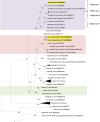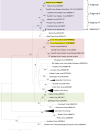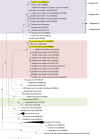Sandfly-Borne Phlebovirus Isolations from Turkey: New Insight into the Sandfly fever Sicilian and Sandfly fever Naples Species
- PMID: 27007326
- PMCID: PMC4805245
- DOI: 10.1371/journal.pntd.0004519
Sandfly-Borne Phlebovirus Isolations from Turkey: New Insight into the Sandfly fever Sicilian and Sandfly fever Naples Species
Abstract
Background: Many studies have presented virus sequences which suggest the existence of a variety of putative new phleboviruses transmitted by sandflies in the Old World. However, in most of these studies, only partial sequences in the polymerase or the nucleoprotein genes were characterised. Therefore to further our understand of the presence and potential medical importance of sandfly-borne phleboviruses that circulate in southern Anatolia, we initiated field campaigns in 2012 and 2013 designed to identify, isolate and characterise phleboviruses in sandflies in this region.
Methodology/principal findings: An entomological investigation encompassing 8 villages in Adana, Mediterranean Turkey was performed in August and September 2012 and 2013. A total of 11,302 sandflies were collected and grouped into 797 pools which were tested for the presence of phleboviruses using specific primers for RT-PCR analysis and also cell culture methods for virus isolation. Seven pools were PCR positive, and viruses were isolated from three pools of sandflies, resulting in the identification of two new viruses that we named Zerdali virus and Toros virus. Phylogenetic analysis based on full-length genomic sequence showed that Zerdali virus was most closely related with Tehran virus (and belongs to the Sandfly fever Naples species), whereas Toros virus was closest to Corfou virus.
Conclusions/significance: The results indicate that a variety of phleboviruses are co-circulating in this region of southern Anatolia. Based on our studies, these new viruses clearly belong to genetic groups that include several human pathogens. However, whether or not Toros and Zerdali viruses can infect humans and cause diseases such as sandfly fever remains to be investigated.
Conflict of interest statement
The authors have declared that no competing interests exist.
Figures






References
-
- Plyusnin A, Beaty BJ., Elliott RM, Goldbach R, Kormelink R, Lundkvist A, Schmaljohn CS, and Tesh RB. 2011. Bunyaviridae In Virus taxonomy: classification and nomenclature of viruses. Ninth Report of the International Committee on Taxonomy of Viruses. San Diego: Elsevier; pp. 693–709.
-
- Collao X, Palacios G, de Ory F, Sanbonmatsu S, Pérez-Ruiz M, Navarro JM, Molina R, Hutchison SK, Lipkin WI, Tenorio A, Sánchez-Seco MP. 2010. Granada virus: a natural phlebovirus reassortant of the sandfly fever Naples serocomplex with low seroprevalence in humans. Am J Trop Med Hyg. 83(4):760–5. 10.4269/ajtmh.2010.09-0697 - DOI - PMC - PubMed
-
- Zhioua E, Moureau G, Chelbi I, Ninove L, Bichaud L, Derbali M, Champs M, Cherni S, Salez N, Cook S, de Lamballerie X, Charrel RN. 2010. Punique virus, a novel phlebovirus, related to sandfly fever Naples virus, isolated from sandflies collected in Tunisia. J Gen Virol. 91(Pt 5):1275–83. 10.1099/vir.0.019240–0 - DOI - PMC - PubMed
Publication types
MeSH terms
LinkOut - more resources
Full Text Sources
Other Literature Sources
Molecular Biology Databases

